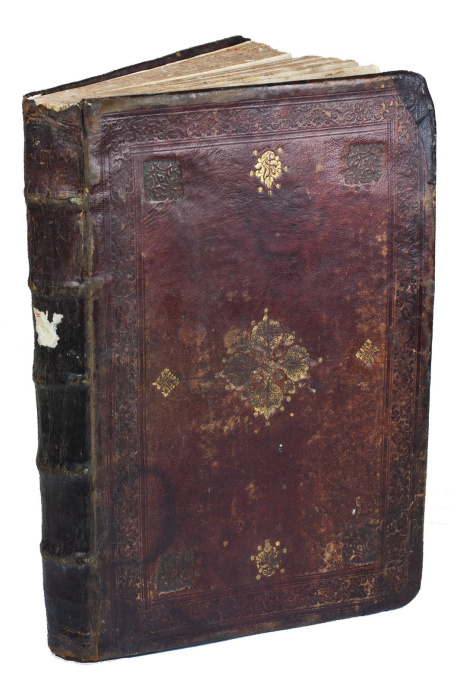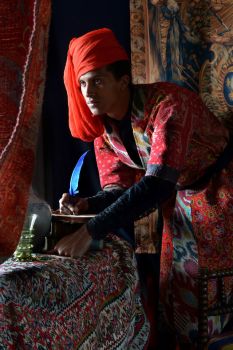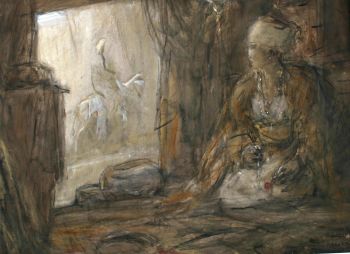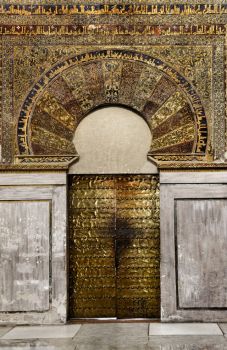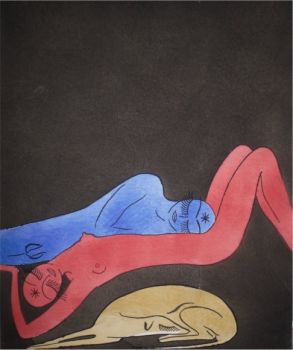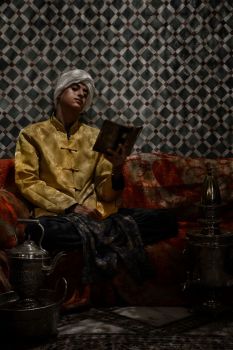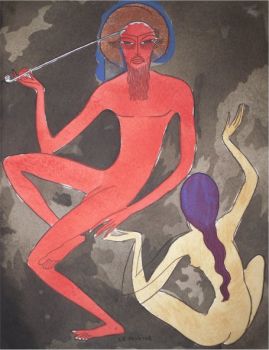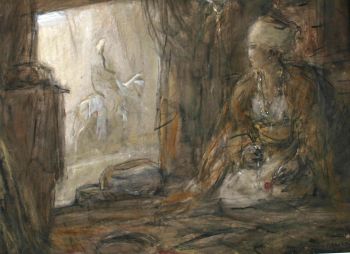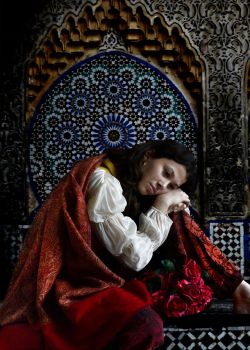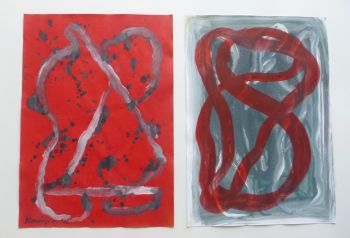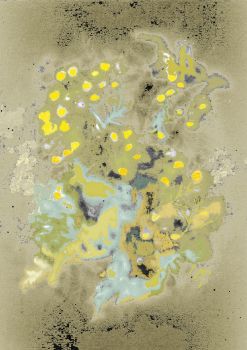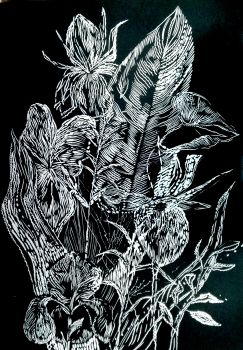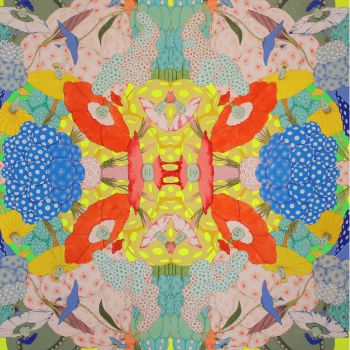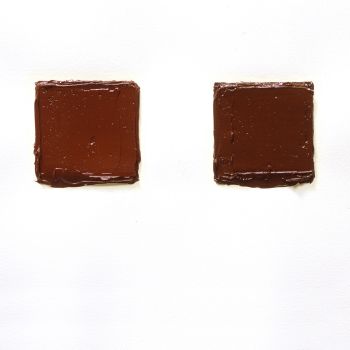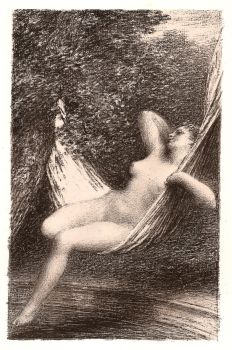Printed and bound at the first Arabic printing office in Lebanon 1776
Monastery of Saint John the Baptist at Dayr al-Shuwayr
PapelCouro
Atualmente indisponível via Gallerease
- Sobre arteKitab al-Injil al-sharif al-tahir wa-al-misbah al-munir al-zahir muqassaman kanayisiyan madar al-sanah hasaba tartib al-Anba al-Qiddisiyin al-Sharqiyin [= Book of the liturgical Gospels].
Dayr al-Shuwayr (or Dhour el Choueir, in Lebanon), Dayr Mar Yuhanna [= Monastery of Saint John the Baptist], [1776]. Folio (31.5 x 22.5 cm). A Greek Melkite Evangeliary in Arabic, with each page in a border of thick-thin rules, pp. 245-300 printed in red and black, and a woodcut Madonna and child. The title-page has been sophisticated, probably in the 18th-century, and appears to be a badly inked proof that has been touched up in manuscript. Bound by the Dayr al-Shuwayr Monastery in contemporary gold- and blind-tooled reddish-brown goatskin morocco, each board with a gold centrepiece.
Very rare second Arabic edition (the first to be printed in Lebanon) of the four Gospels arranged for liturgical use in the Greek Melkite Church, to make readings for services according to the day of the year: a so-called Evangeliary or Evangelion. It was intended primarily for Arabic-speaking Christians in the Middle East, rather than for missionary work. The first Arabic edition was printed and published at Aleppo in 1706. Al-Shamas Abdallah Zakher (1684-1748), son of an Aleppo goldsmith, worked at the Aleppo printing office but had to flee in 1722 because of disputes that were to lead to the 1724 schism in the Melkite Church. Zakher established the printing office of the Melkite monastery of St. John the Baptist at Dayr al-Shuwayr in the Lebanese Kisrawan mountains, where he produced a psalter in 1734. He is said to have been skilled in jewelry-making and cutting in metal and wood, and to have cut the punches for the 1734 Arabic type. The printing office produced about 70 Arabic editions before it closed in 1899.
With marginal manuscript notes in Arabic script, the stamp of a Diyarbakir (in Anatolia, eastern Turkey) library in the margin of the last page. With the title-page sophisticated as noted, some mostly marginal water stains, an occasional small stain, a tiny and unobtrusive worm hole in the second half, but mostly in good condition and with large margins. The binding rubbed and slightly chipped, with the front hinge and fore-edge corners restored and the inside front hinge reinforced. Very rare early example of an Arabic liturgical work, printed and bound at the Monastery of St John the Baptist in Dayr al-Shuwayr, Lebanon.
Darlow & Moule 1661; KVK & WorldCat (3 copies); Schnurrer 360; for Zakher: J.E. Kahale, Abdallah Zakher (2000); Hanebutt-Benz et al., Middle Eastern languages and the print revolution (2002), pp. 179-181. - Sobre artistaA Ordem Chouerita Basiliana de São João Batista é uma ordem religiosa da Igreja Católica Grega Melquita. O nome latino dessa ordem é Ordo Basilianus Sancti Iohannis Baptistae, o nome francês é Ordre Basilien Chouerite de Saint Jean Baptiste, a abreviação usada após o nome é B.C. Esta ordem foi encontrada em 1696 por cinco monges (incluindo Neophytos Nasri) que deixaram o Mosteiro de Balamand em busca de um lugar tranquilo onde melhor seguir a regra de São Basílio. Eles se estabeleceram em 1710 na vila de Choueir (ou Dhour El Shuwayr, perto de Khinchara) no Monte Líbano usando a pequena igreja de São João Batista, da qual eles tomaram o nome e que ainda é sua casa-mãe. Em 1733, Abdallah Zakher fundou um Impressora em língua árabe usando tipos móveis no mosteiro de São João em Choueir, a primeira impressora caseira no Líbano. [4] Em 1757, o Papa Bento XIV aprovou suas regras particulares, e a aprovação final de Roma foi dada em 1772. A Ordem Salvatoriana Basiliana logo se tornou uma das duas principais ordens religiosas da Igreja Católica Melquita. A outra ordem era a Ordem Salvatoriana Basiliana. De acordo com sua tradição, a Ordem Salvatoriana Basiliana tinha um objetivo mais missionário, enquanto a Ordem Chouerita Basiliana era mais contemplativa. A Ordem Salvatoriana Basiliana recrutou nas áreas de Damasco e Sul do Líbano, enquanto a Ordem Chouerita Basiliana recrutou nas áreas de Aleppo, Homs, Norte do Líbano e Galiléia. As tentativas de unir essas duas ordens no século 18 falharam: a oposição entre elas e entre as diferentes comunidades das quais recrutam membros é um aspecto importante a ser entendido na história inicial da Igreja Católica Melquita. Entre 1824 e 1832, a ordem se dividiu em dois ramos: a Ordem Basiliana Alepiana (formada principalmente por monges que vieram da área de Aleppo) e os Baladitas ou Ordem Chouerita Basiliana (que veio principalmente do Líbano e da Galiléia). A ordem fundou seu seminário em 1880 e dirige muitas paróquias no Oriente Médio. Três Patriarcas Melquita e cerca de 36 bispos eram membros dos Choueritas Basilianos. A primeira edição árabe foi impressa e publicada em Aleppo em 1706. Al-Shamas Abdallah Zakher (1684-1748), filho de um ourives de Aleppo, trabalhava na gráfica de Aleppo, mas teve de fugir em 1722 por causa de disputas que levariam a o cisma de 1724 na Igreja Melquita. Zakher estabeleceu a gráfica do mosteiro melquita de São João Batista em Dayr al-Shuwayr nas montanhas libanesas de Kisrawan, onde produziu um saltério em 1734. Diz-se que ele era hábil em joalheria e corte de metal e madeira, e ter cortado os punções para o tipo árabe de 1734. A gráfica produziu cerca de 70 edições em árabe antes de fechar em 1899.
Artwork details
Related artworks
Engelbert Kaempfer
LIVRO ENGELBERT KAEMPFER1651 - 1716
Preço em pedidoZebregs & Röell - Fine Art - Antiques
Tilmanus Nicolaus Maastricht
Missale Romanum com montagens de prata holandesa1788 - 1792
Preço em pedidoJacob J. Roosjen SRI
Yoko Ono
YOKO ONO: "ARISING" SIGNED BOOK PLUS SMALL ARTWORK 2010 - 2014
Preço em pedidoGallerease Selected
Tilmanus Nicolaus Maastricht
Missale Romanum com montagens de prata holandesa1788 - 1792
Preço em pedidoJacob J. Roosjen SRI
Engelbert Kaempfer
LIVRO ENGELBERT KAEMPFER1651 - 1716
Preço em pedidoZebregs & Röell - Fine Art - Antiques
1 - 4 / 22Elisabeth Treskow
Lápis-lazúli afegão incrustado com ouro em um suporte de prata1950 - 1960
Preço em pedidoJacob J. Roosjen SRI
1 - 4 / 24- 1 - 4 / 24

